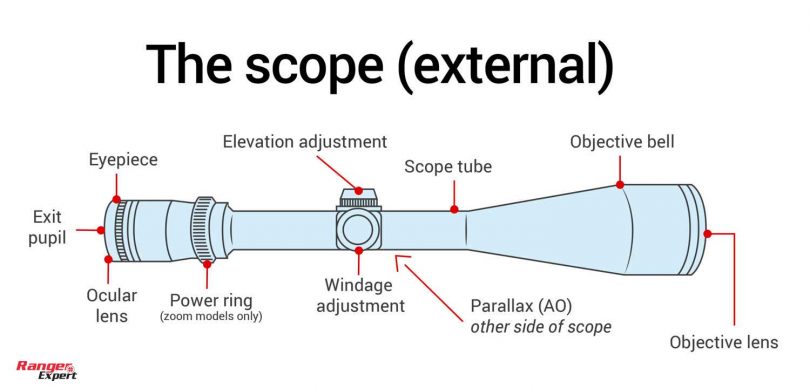A scope is an essential tool used by various professionals, from hunters to engineers.
Understanding rifle scopes is essential to maximize their effectiveness and get the most out of them. Scopes use optics, such as lenses and prisms, combined with mechanics like springs and gears, to magnify distant objects or measure tiny distances.
In this blog post, we’re going to teach you the basics of scopes and how they work. To keep it simple, we’ll focus on just rifle scopes today.
We’ll explain questions like what all the different parts do, how does scope magnification work, how does a rifle scope adjustment work, and more.
We’ll also share some tips on getting the best out of your rifle scopes.
Whether you’re a beginner hunter, archer looking to improve accuracy, or just looking to learn more about scopes, read on to explore the answer to our today’s topic: How does a scope work?
Let’s get going!
How Does a Scope Work: Anatomy and Working Principle
A rifle scope is an optical device that increases accuracy and precision when aiming a firearm. It works by magnifying the image of the target, allowing the shooter to see more clearly and accurately.
Different types of rifle scopes have different features and components. For example, the best rimfire scope may not have the same features as a long-range scope. Generally, however, all scopes have the same basic components.
The most common hunting rifle scopes use refraction to bend light through a series of lenses and prisms, creating an enlarged image that can be viewed from a distance. This image is usually brighter and clearer than what can be seen by the naked eye.
Rifle scopes typically have adjustments for windage (horizontal) and elevation (vertical). These allow for fine-tuning the scope settings.
Anatomy of a Rifle Scope

Now, let’s dive into the main parts of a rifle scope and explore how they work:
Objective Lens
The lens is located at the front end of your scope, gathering light from the outside environment so you can see your target clearly.
Ocular Lens or Eyepiece
This is the lens you look through, which contains a series of lenses that magnify your view. It also usually has windage/elevation adjustments to adjust for the target’s movement relative to you.
Reticle
The reticle is located in the center of your field of view with various patterns such as dots, crosshairs, circles, and rectangles that help aim accurately by providing reference points for aiming or measuring distances/angles.
Scope Adjustments
These are small knobs at the eyepiece or on the side of your scope that allow you to adjust for image quality and positioning.
A scope uses three primary types of adjustment: elevation adjustment (scope height), windage adjustment (left/right), and parallax adjustment (angle).
This adjustment is used to correct any discrepancies in the image (parallax error) when looking through the scope from different angles. We’ll talk more about them in the next section.
Magnification Level
The magnification level of a rifle scope is determined by its lenses, typically ranging from 4x-20x depending on what type of shooting you intend to do.
The number usually means how much the image can be magnified. For example, a 3X magnification scope will enlarge the final image 3 times what you can see with your naked eyes.
Scope Rings
Also known as mounting rings, scope rings are a necessary part of mounting your scope to your rifle. They come in different sizes and materials, such as aluminum or steel, depending on the size of your scope and the type of mount you use.
High-quality scope rings should be sturdy and securely attach the scope to the weapon to ensure it will stay in place during recoil.
Casing Tube
The tube holds the entire setup and protects the scope from the elements, especially dust and moisture.
Also, the tube holds a tiny amount of gas like nitrogen, argon, or any other chemical that absorbs moisture. This provides a sharp image even in the roughest of weather.
Working Principle of a Scope
The working principle of a rifle scope is based on several parts: an objective lens, a reticle, an eyepiece, and adjustments.
The objective lens is located at the front of the scope and collects all available external light from the environment.
This light goes through a prism or series of lenses inside the scope until it reaches your eye, creating an enlarged and focused image.
Next comes the reticle, a pattern within the center of your field of view that helps you measure distances or aim more accurately by providing reference points for aiming.
Finally, the eyepiece is what you look through, and it contains a series of lenses that magnify your target. It also allows you to control adjustments like zoom power and windage/elevation.
By combining these parts correctly, scopes allow shooters to see their targets from far away with increased clarity and accuracy.
How Does Scope Magnification Work?

Now that you know the basics of a rifle scope, let’s discuss magnification.
The magnification range/level of any scope is determined by its lenses, and it typically ranges from 4x-20x depending on what type of shooting you’re looking to do.
Scopes with higher magnifications are usually better for long-range shooting but come at the cost of field of view. They provide more enlarged images but allow less light to enter through the lenses.
Lower magnification scopes tend to have more light-gathering capabilities, making them ideal for close to medium-range shooting.
In addition to magnification levels, some scopes also feature variable zoom, allowing you to adjust the magnification range while keeping your target in focus. This makes it easier to quickly switch between different distances without taking your eyes off the target.
Scope Lenses: What You Should Know
When it comes to rifle scopes, lens quality is vital. The lenses are the most essential part of any scope, as they gather light from the environment and focus it for you to see a clear image.
Two main types of lenses are used in rifle scopes: single-coated and multi-coated.
Single-coated lenses are made with a single layer of anti-reflective coating which reduces reflection and glare from the sun.
Multi-coated lenses provide superior light transmission due to multiple layers of anti-reflection coatings that help reduce glare even more effectively.
Multi-coated lenses are typically better for low light conditions, while single-coated lenses perform better in brighter environments.
More on Scope Adjustments
Scope adjustments are what allow you to fine-tune your shooting accuracy. This includes adjustments like windage/elevation, parallax, and reticle focus.
Windage/elevation adjustments help adjust for the target’s movement relative to you, so you can maintain a steady aim even if your target is moving.
Parallax adjustment helps correct any discrepancies in the image when looking through your scope from different angles. And finally, the reticle focus adjusts how clearly the reticle appears in the scope’s field of view.
What Do the Numbers Mean On a Rifle Scope?
The numbers printed on your rifle scope indicate its magnification level. For example, if you see a 3-9x40mm written on the side of your scope, it means that it has an adjustable magnification between 3x and 9x with a 40mm objective lens diameter.
For a fixed magnification scope, the number will be just one. For example, if you see a 6x42mm written on the side of your scope, it means that it has a fixed magnification of 6x and an objective lens diameter of 42mm.
What About The Reticle?
Also known as the crosshair, the reticle is the pattern located in the middle of your scope’s field of view, and it helps you accurately measure distances or aim at targets.
Reticles come in all sorts of shapes, sizes, and patterns, such as duplex, mil-dot, BDC (bullet drop compensator), crosshairs with a circle, or even illuminated reticles that glow in low light conditions.
The type of reticle you choose will depend on what type of target you are shooting at and how far away it is from you.
Congratulations! Now you know how does a rifle scope works and what you can do to increase the accuracy of your sight.
And with that, we’re at the end of our discussion today. This guide provided a simplified overview of rifle scopes, their anatomy, and their working principle. We hope it has helped you understand the scope basics better.
Hopefully, all the information in this post will help you choose the right scope for your rifle and make the most out of your scopes. Thanks for reading this far, and happy shooting to you!
FAQs
Q. What Are Coated And Multi-Coated Lenses, And How Do They Differ?
Coated lenses are made with a single layer of anti-reflective coating which reduces reflection and glare from the sun. Multi-coated lenses provide superior light transmission due to multiple layers of anti-reflection coatings that help reduce glare even more effectively.
Q. What Adjustments Can I Make To A Scope To Increase Accuracy?
To increase accuracy, you can make windage/elevation, parallax, and reticle focus adjustments to your scope. Windage/elevation adjustments help you adjust for your target’s movement relative to you.
Parallax adjustment helps correct any discrepancies in the image when looking through a scope from different angles. And reticle focus adjustments help you adjust how clearly the reticle appears in the scope’s field of view.
Q. What Should I Look For In A Reticle When Buying A Scope?
When looking for a reticle, you should consider the size and type of your target and how far it is from you.
For example, a duplex or mil-dot reticle might be ideal if you are shooting at a small target at long range. However, if you are shooting at a larger target at a short range, then a BDC or illuminated reticle might be more suitable.
Q. How Can I Measure My Scope Height?
To measure your scope height, you’ll need to first identify the center of the scope tube where the scope mounts. Then measure from the bottom of the scope tube to the center of the objective lens. The measurement you get is your scope height.








Leave a Comment